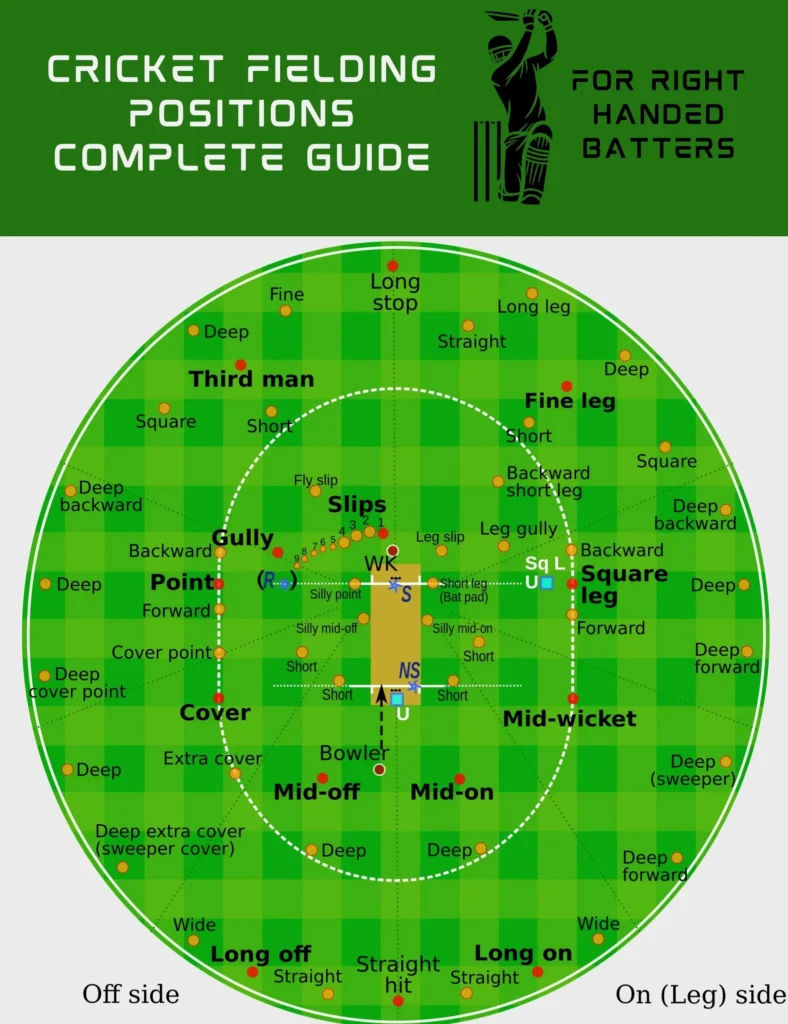Field Setting for a Leg Break Bowler – A Complete Guide
Published: 26 Jan 2025
A leg break bowler can be a match-winner, but only if the right field is set. The goal is to create pressure, force mistakes, and take wickets. A smart field setting for a leg break bowler helps control runs while making batters play risky shots. Let’s break down how to place the field effectively.
Understanding a Leg Break Bowler’s Game
A leg break bowler spins the ball away from a right-handed batter. The movement is difficult to handle, especially on turning pitches. The bowler’s main weapons are:
- The Movement: The ball moves sharply after landing on the pitch and sometimes also in the air.
- Variations: Leg break bowler can move the ball in both directions in the same bowling action. Googly is the lethal bowl that comes back into the right-handed batters.
- Bounce: Extra lift surprises the batter and creates catching chances.
To get the best results, the field must support the bowler’s strengths.
Basic Field Setup for a Leg Spinner
A standard field for a leg spinner focuses on stopping easy runs while creating wicket-taking chances. Key positions include:
Close Fielders (For Catches)
- Slip: Stays behind the batter to catch edges.
- Short Leg: Positioned near the batter’s front leg for bat-pad catches.
- Silly Point: Stands very close on the off-side to grab sharp chances.
Run-Stopping Fielders
- Point & Cover: Stops cut shots and drives.
- Mid-Wicket & Mid-On: Blocks flicks and pushes.

Deep Fielders (For Big Shots)
- Long-On & Long-Off: Protects against lofted drives.
- Deep Mid-Wicket & Deep Square Leg: Catches mistimed shots.
This setup works in most situations. However, adjustments are needed based on the batter, pitch, and match situation.
Attacking Field for Wickets
When the pitch offers turn or the batter is struggling, an aggressive field is the best option. This setup builds pressure and forces mistakes.
Key Changes for an Attacking Field
- Two Slips & Short Leg: Creates more catching chances.
- Silly Point & Leg Slip: Traps the batter with close fielders.
- Deep Mid-Wicket & Deep Square Leg: For mistimed sweeps and pulls.
When to Use This Field:
- When the pitch is dry and turning.
- Against new batters who are not settled.
- When the bowler is in good rhythm.
This field works best when the bowler is bowling a tight line and varying their pace.
Defensive Field for Controlling Runs
If the batter is attacking or the pitch is not helping the bowler, a defensive setup is needed. The goal is to stop boundaries and force the batter to take risks.
Key Changes for a Defensive Field
- Deep Cover & Deep Mid-Wicket: Stops fours on both sides.
- Long-On & Long-Off: Protects against straight lofted shots.
- Sweeper Cover: Blocks extra runs from powerful off-side shots.
When to Use This Field:
- Against an aggressive batter looking to score quickly or sometimes inviting batter to go for big shorts and create catching chances.
- When the bowler is struggling to find the right length.
- In the later overs of a limited-overs match.
This setup limits scoring options and forces the batter to play riskier shots.
Batter Based Field Adjustments
Every batter has different strengths and weaknesses. A good captain and bowler will adjust the field accordingly.
Against Aggressive Batters
- Keep deep fielders to stop boundaries.
- Maintain at least one slip for edges.
- Bowl slightly wider to force mistakes.
Against Defensive Batters
- Bring in close fielders to increase pressure.
- Place a silly point and short leg to create catching chances.
- Bowl slower and give the ball more time to spin.
Against Left-Handed Batters
- Mirror the field positions for right-handers.
- Keep a leg slip and short leg for inside edges.
- Target the off-stump line to create doubt.
A batter who is uncomfortable against spin will struggle when the field is set correctly.
Common Mistakes to Avoid
Even experienced captains make mistakes when setting a field for a leg spinner. Here are some errors to watch out for:
1. Leaving Gaps for Easy Singles
If batters can rotate the strike, they will not feel pressure. Always have fielders placed to stop quick singles.
2. Not Having a Slip When the Ball is Turning
A turning ball increases the chance of an edge. At least one slip should always be present when the pitch offers spin.
3. Ignoring the Batter’s Strengths and Weaknesses
If a batter loves to play cover drives, don’t leave gaps in the off-side. If they struggle against spin, keep attacking fielders in place.
4. Failing to Adjust After Every Over
A smart captain moves fielders constantly. If a batter starts hitting in one area, adjust the field to stop them.
Final Thoughts
A great leg spinner can change a game, but only if the field is set correctly. Whether you want to take wickets or stop runs, the right-field placement makes all the difference.
- Use an attacking field when the pitch is turning.
- Switch to a defensive field against set batters.
- Keep adjusting based on the batter’s strengths and weaknesses.
With the right field, even an average bowler can become a threat. Smart cricket is all about reading the game and making small but effective changes.

- Be Respectful
- Stay Relevant
- Stay Positive
- True Feedback
- Encourage Discussion
- Avoid Spamming
- No Fake News
- Don't Copy-Paste
- No Personal Attacks

- Be Respectful
- Stay Relevant
- Stay Positive
- True Feedback
- Encourage Discussion
- Avoid Spamming
- No Fake News
- Don't Copy-Paste
- No Personal Attacks





